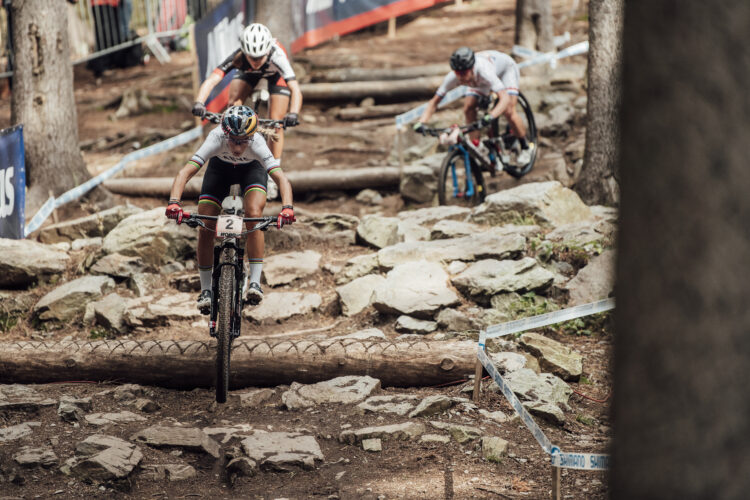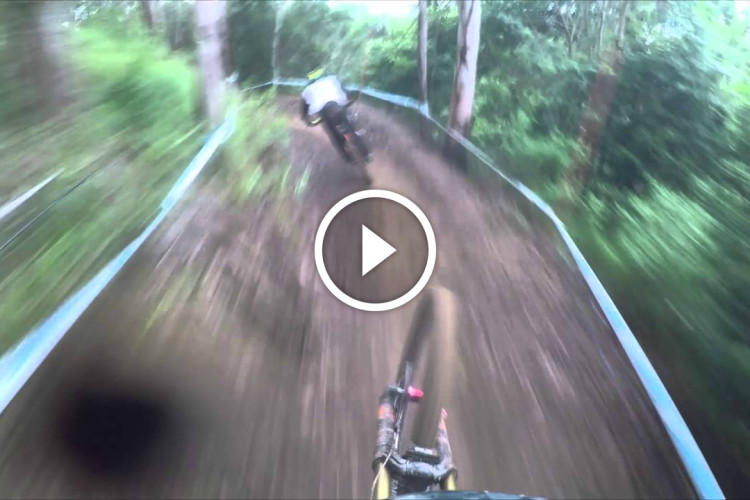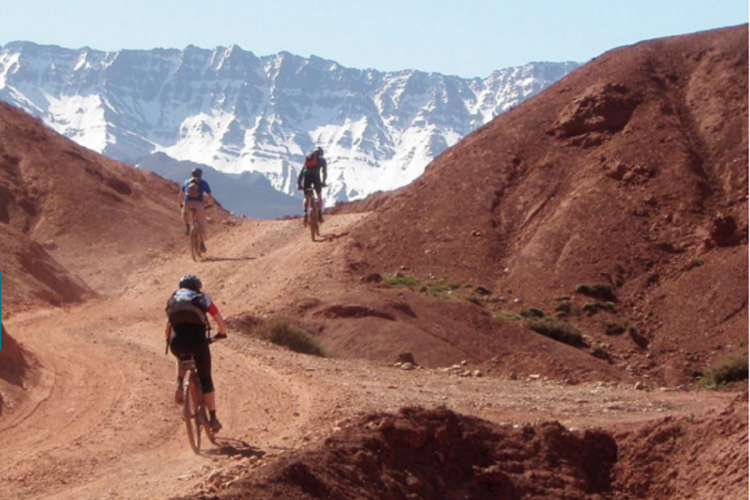
Now in his tenth year promoting the World Cup race in Nove Mesto Na Morave, Czech Republic, co-organizer Jan Marcaník has the annual process nearly dialed. I spoke with Marcaník in late September, and he said that full scale planning had already begun for the 2020 event. Though promotion and logistical discussions for World Cup races take place year round, it becomes his full time job just as his other work as an MTB tour guide with Czech MTB Holidays tapers off for the season.
The course in Nove Mesto has a long, rooty climb and a few notable rock gardens that riders look forward to every year. For 2019 the course was one of only two World Cup XC events that took place without a downhill World Cup at the same venue. The DH races attract a massive number of visitors, and without that gravity draw, the XC event promoters have to work extra hard to entice spectators.
Here’s a peek into how it all works, with Jan Marcaník himself.

So Jan, how did you get started working with the World Cup crew?
Well, I got involved about 10 years ago. At the time I was a university student and it was my part-time job for just a week or two. I was mountain biking and I had some friends in a company who were organizing the event at the time. They kind of told me to come and help them. I think that the first year I was responsible for some driving a few UCI officials [around] and within the next few years, it evolved into more and more involvement. Nowadays, I’m pretty much the only person who’s working on the World Cup all year round, along with the owner of the company.

How is the race organized annually? You mentioned that you’re about to start working on it. What’s happens, from start to finish?
First of all, it’s about the money. We are trying to work with our partners and keep them involved all year ’round and plan their [visibility] onsite as well as in the TV broadcast. Trying to keep them involved so that they feel like they’re part of it. That’s important.
Also it’s about, talking to the authorities like Czech tourism, which is also supporting us. [Including] the Czech tourism board, official tourism board, or a regional tourism board, and the town of Nove Mesto, which is also involved in helping us with a little budget.
So it’s basically about having business meetings and, you know, going through the last race, which we had in May, watching a TV broadcast again, and, seeing what there is, what could be made differently and better. It’s not too much work now but you need to keep thinking about little things that [make it] better next year.

How does the World Cup race benefit the town of Nove Mesto?
Well, because it brings a huge [amount of] tourism there. Our race, which is probably the one that has the most visitors. We can attract up to like 15-20,000 people who come to Nove Mesto, and they spend a night or two or three. And they’re spending their money there. So, you know, it helps the guest houses, the restaurants, all the services just to raise more money. So that’s the reason why the local municipalities should support it as well.

How much does the course change year to year?
When I look back to 10 years ago, the course was different. It was way longer. Within the first years of the World Cup, we understood that if you want to have a good course, that means first it has to be fun for the riders, and second, convenient for the visitors. The course will not be convenient if, for example, it’s on a large area. It needs to be kind of like a zig-zagged through the forest. And we have a nice forest, there’s good visibility and not too many bushes. It’s pretty much all on one bank. Over the years we have found that it makes the most sense to make the course go up the hill and down the hill, in a zigzag.

The fans can actually walk along the course and in one loop, they can see the riders three or four times easily. So if they come for a men’s race, which is 90 minutes, they first see the start, which is a huge atmosphere because there are giant grandstands with 8,000 visitors. By the time they start, it is packed with people. So it’s a great atmosphere.
Right after the start, all those people just run into the forest to see everything around the course. They’re running from place to place, and within those 90 minutes, they can see the riders, not seven times because the riders make seven laps. They can see them 20 times easily, and in really attractive spots like rock gardens or drops or you know, these kinds of obstacles that are interesting. I would say that our race, first of all, is attractive for the visitors, and obviously, when there are visitors, that’s something that the sponsors like.
Do you build space specifically for spectators to stand in the forest near different track features?
Yeah. We actually have mobile grandstands in the forest.

The recent shift from eliminator racing the day before the big XC event, to the UCI using short track races as a qualifier for the main event is quite significant. How has that affected things from your perspective?
We were the first [race promoters] who supported the idea of short track and eliminator races. In 2012 or ’13, after the first and second World Cup, we immediately understood that if we want to bring visitors to the area on Friday and Saturday prior to the main event, we needed to have the top-level riders racing those days as well. So that’s why we strongly supported the idea of eliminator.
From the very beginning it was a mistake that the UCI did not include eliminator in the UCI points. They didn’t include it in the cross country ranking. So there was a separate ranking or separate standings for eliminator and cross country. The cross country riders after one season stopped riding the eliminator and it evolved into two disciplines and two different kinds of heroes. The guys who would win the eliminator wouldn’t be able to win the cross country and that was a huge mistake. That’s why the eliminator ended.
A few years later we supported the idea of short track, which we saw organized at Sea Otter in the States. We strongly pushed UCI and we organized quite a large appeal of World Cup organizers [asking the UCI to] add short track as another discipline of the World Cup.
Short track is now a good way to bring visitors into the area on Friday. Then, you need to prepare something super extra for Saturday because on Saturday we only have the U23 and junior races. Even though the efforts of the [younger] riders are great, you know people want to see the top-class riders.
Do you feel that if you had a downhill race attached to your event you would have more visitors?
If there was a chance to organize the downhill race, we would go for it. We just don’t have such a big mountain. I would say, if it’s a cross country and downhill event, then you have something for the spectators for all three days.
It’s important to add that the visitor groups are different. I mean, there would probably be 40 or 50% of the people who would go and watch downhill as well as cross country, but another 50% of people who would only come specifically for downhill. Also, it’s hard to watch a downhill race. You see the rider just once on the course.
What does the future of this Czech race look like?
When we think about the future, we would want to have the World Champs once again in our country. We’re thinking about organizing the World Champs of cross country as well as downhill. It would have to be a little bit specific, like two different venues, but there are mountains that could hold a downhill race. So we’re now discussing World Champs 2025

What would you say is one of the biggest challenges to setting up the race?
It’s the money and convincing the sponsors that their attendance will be something that they will benefit from. Organizing the World Cup in the Czech Republic means a budget, of about 400,000 to 500,000 euros. If you do everything right, you are able to get about one-third of the budget from the government. So the state, the regional, municipality, and the town.
That means you still need to raise about 250,000 euros from sponsors, ticketing, merchandising, and whatever you are able to sell in the venue. If you have not tried to convince a private company to give you 100,000 euros, you don’t know how it is. It is tough. It means a lot of preparation and creativity. You need to find ways to make them feel involved. You have to give them new ways to display their products, to get their products into the TV broadcast if it’s something that you cannot just put next to the track.
Who are some of the best sponsors you’ve worked with? Who really helps you guys out?
We are super happy to work with Mitas Tyres, Mercedes Benz, and Cannondale, among other helpful companies.

There you have it. Throwing a World Cup mountain bike party requires loads of meetings, marketing, investment allocation, volunteer management, and a few hundred small pieces that Marcaník and I couldn’t fit into the time span of three beers. You can watch the pro women’s and men’s events live on Redbull.com.




















0 Comments